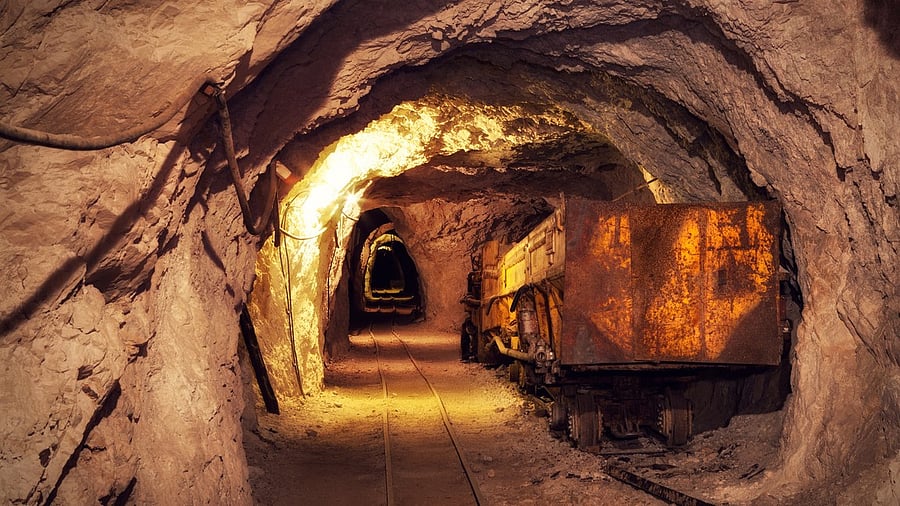
Image showing the shaftb of a gold mine. For representational purposes.
Credit: iStock Photo
Lima, Peru: The bodies of 13 gold miners were found in an underground shaft at a site operated by Peru's largest gold-mining company, President Dina Boluarte said Monday, in a region that has seen growing conflict over access to ore in recent years.
As the price of gold has climbed to record highs, small-scale mining has expanded in Peru, while the mining concessions of the Peruvian company, La Poderosa, in Pataz province in the northern part of the country, have become a hotbed of illegal gold mining and the site of deadly clashes.
The bodies were found Sunday, according to Boluarte. The men had worked for an artisanal, or informal, mining operation that has a contract with La Poderosa, the company said in a statement Sunday.
A video circulating on social media appeared to show the miners, blindfolded and naked in a mining shaft, being shot in the neck with rifles one by one. One person is heard begging, "Please." A representative of the national police told The New York Times that officials had not verified the authenticity of the video.
It was not immediately clear why the 13 men were killed. La Poderosa said in its statement that armed criminals had attacked the mining operation and kidnapped the workers April 26.
Boluarte said two people suspected of being connected to the killings had been arrested in Pataz with guns, magazines and ammunition.
The owner of the artisanal mining operation that hired the workers, Segundo Nicolás Cueva Rojas, did not immediately respond to requests for comment via phone and email.
Before the bodies were found, some of the workers' relatives had complained to the local news media that authorities were not doing enough to find their loved ones.
"We demand justice," Abraham Domínguez, the father of a victim, Deyter, 29, told the local radio program Exitosa. "This cannot go unpunished. This isn't an animal that was killed. These are human beings."
He told the Times that his son "wanted to prosper, to be someone in life." He added: "He had a strong desire and will to move forward. Now he's gone."
He also said it wasn't the police who had found the bodies, but self-defense patrols known as "ronderos" that operate in highland areas.
Peru is the second-largest producer of gold in Latin America, after Mexico, and the 10th-largest global producer alongside Indonesia, according to 2024 data from the US Geological Survey. Peru has long struggled to restrict illegal gold mining, especially in remote Amazonian regions where wildcat mines have destroyed tens of thousands of acres of rainforest and dumped mercury into rivers.
During pandemic lockdowns, criminals seized control of empty mining shafts operated by authorized artisanal miners at La Poderosa, prompting deadly battles over access to the tunnels and the gold produced inside.
Part of the problem, experts say, is that Peru allows artisanal miners who register with the government to be exempt from police evictions, as well as labor, environmental and tax laws, providing legal cover for illegal miners who operate in forbidden areas or without the permission of concession holders.
In its statement, La Poderosa blamed Peru's Congress in part for the spiraling violence, saying it had extended the deadline by which informal miners must fully legalize their operations, and it blamed the government for failing to remove unauthorized miners from its list.
"Pataz has become a lawless territory where violence runs rampant, taking lives, sowing terror and subjugating wills," the statement said. "It will be impossible to defeat crime if, despite our repeated requests, the police continue to fail to enter and interdict the illegal mine entrances where criminal gangs take refuge and operate."
In December 2023, nine people were killed in a mining ambush by criminals, and in October, authorities found 16 bodies in a mass grave in one mining shaft.
On Saturday, as authorities searched for the missing men, police rescued 50 workers from another Peruvian mining company, Caravelí, who had been taken hostage at the company's gold-processing plant in a different part of Pataz province, according to Peru's state news agency. Eight people were injured in a shootout between police and armed men.
In response to the latest massacre, Boluarte suspended mining activity in the Pataz area for 30 days and pushed the military to restore order. On Monday, she announced a curfew from 6 p.m. to 6 a.m. in the Pataz district, and said authorities would install a military base there.
The mayor of Pataz province, Aldo Carlos Mariño, said a state of emergency in place in the province for the past year had been "useless," and urged the government to improve intelligence operations to stop the criminals behind the violence.
"We give everything to the country; we give it all our gold," Mariño said on a local TV station Sunday. "The province of Pataz is covered in blood."
This article originally appeared in The New York Times.